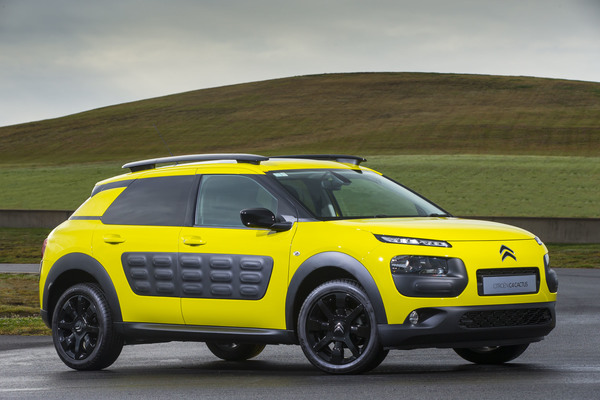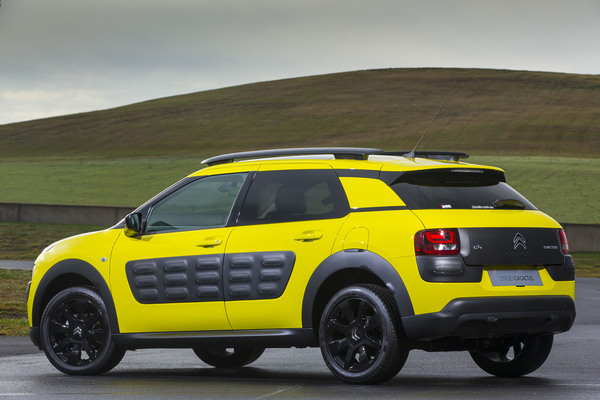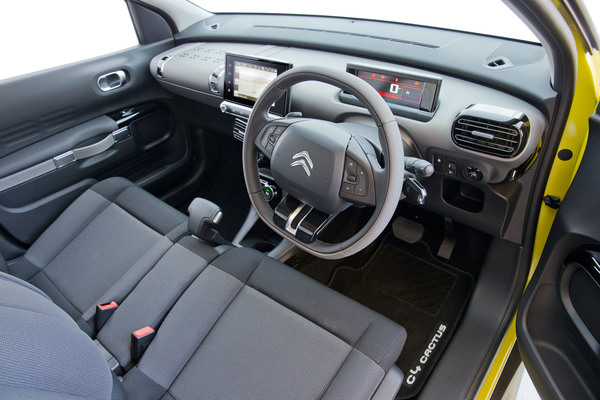By Derek Ogden
IT’S hard to take seriously a car that’s named after a spiky plant that lives in desolate sun-scorched, rock-strewn deserts.
There again, to exist in such a harsh and lifeless environment shows a degree of strength and the ability to adapt.
Maybe this is what Citroen had in mind when it thought up the moniker ‘Cactus’ for its compact hatchback.
The Citroen C4 Cactus comes in two Exclusive versions featuring extensive standard equipment and reasonable pricing – $26,990 for a turbocharged PureTech petrol manual and $29,990 for a semi-automatic diesel variant. Both prices are plus on-road costs.
Premium paint added $800 to the test car powered by a 1.2-litre turbocharged three-cylinder petrol engine mated with a five-speed manual transmission.
A wide range of options is available at extra cost, including coloured Airbumps, roof rails and door mirrors, wheel rims, contrasting colour body highlights, interior options and a palette of vibrant exterior colours.
Things have gone quite ‘Gaudian’ on the outside, with quirky architecture designed to catch the eye. Multi-shaped panels in contrasting colours appear to have been stuck on, front and back.
Then there’s the Citroen patented Airbump protection on the flanks to guard against damage to bodywork from minor bumps at speeds of less than four kilometres per hour, for example from the dreaded shopping-centre trolleys or doors of other cars.
Air encapsulated between two cushions soaks up any impacts. The outer thermoplastic panel comes in contrasting body colours such as standard black, or optional Chocolate (brown); Dune (off white), or grey.
Seventeen-inch two-tone Cross alloy wheels add a further level of distinction. However, underneath the bits and pieces, the shape of the C4 Cactus is stylish, up to date and rather appealing.
Forget the exterior frippery, the cabin interior dips its cap majorly to minimalism. The simplicity of the dashboard and centre stack is pleasing, with a no-nonsense layout of controls inside the perimeter of a 7.0-inch touchscreen at a handy level.
An easy-to-read digital display directly in front of the driver offers information on vehicle speed, fuel level and the odometer reading.
Driver and front passenger settle into wide seats, while the passenger benefits from an airbag in the roof creating more room in front of them. There’s handy storage space.
An optional panoramic glazed roof provides extensive cabin heat proofing.
Windscreen washer nozzles are built into the tips of the flat wipers depositing a small quantity of fluid over the length of the blade; thus maintaining driver visibility throughout the process for greater safety and halving the amount of liquid used.
In these digital days the C4 Cactus is well connected, with a fully digital interface grouping all controls and digital screen replacing an instrument cluster. Simple, clean graphics make the touchscreen easy to use with a minimum of inattention.
Bluetooth offers hands-free connection, plus access to a phone directory. Music can be stored on the vehicle hard disc and devices can connected via the USB and iPod ports.
AM, FM radio and digital radio delivers good sound quality from five speakers and one subwoofer. DAB has more stations than on FM, as well as functions such as pause and rewind.
An Arkamys system creates a made-to-measure sound adapted to the vehicle interior, improving the distribution of music and vocals around the cabin.
Two drivetrains are offered a PureTech 1.2-litre turbocharged three-cylinder petrol engine, putting out 81 kW of power and 205 Nm of torque, paired to a five-speed manual transmission, or a 68 kW, 230 Nm 1.6-litre turbo-diesel mated with a six-speed semi-automatic transmission.
Six airbags and ABS anti-locking brakes have electronic brake force distribution and emergency brake assist.
The front passenger’s airbag is mounted in the roof. Its ‘comma-shape’ ensures that it inflates correctly regardless of the passenger’s position.
At the same time, the volume has been increased to 120 litres to cover the touch screen area.
Add to this electronic stability program and hill start assist and the Cactus is up there with the best in standard safety features in this segment.
There’s no doubt the C4 Cactus is a head-turner, attracting attention and varied comments through my time with the visual trend-setter.
The three-cylinder motor showed its shortcomings when pushed on overtaking but accelerated from rest competently, if a little noisily.
Cabin comfort up front was impressive for this segment and the layout and simplicity of the instruments and touch-screen controls made the driver’s job easier than with some rivals.
Gearchanges with the long-throw lever were so laidback as to be almost sleep inducing, if it weren’t for the diffident selector – not so bad when there are only five gears to choose from.
A sixth cog, normally found in manual transmissions these days, and more assured lever action, would be a welcome addition.
There was no argument with fuel consumption from the 1.6-litre turbo-petrol motor, with 7.1 litres per 100 kilometres on day-to-day use around the suburbs and a very pleasing 3.9 litres per 100 cruising the motorway.
Steering the Cactus presented no problems thanks to the variable electric system and was particularly effective when parking the vehicle despite its almost 11-metre turning circle.
Braking had to be handled with some concentrated effort, being a bit slow on responding to pedal effort.
As for the Airbump, the fact of having such padding could be considered a red-rag-to-a-bull challenge to ram the section – the dodgem car syndrome. Oops!
With Citroen claiming a total of 23,184 Cactii combinations, among the many quirks there has to be a Cactus to suit anybody. A six-year unlimited kilometre warranty is appealing too.
Model range
Citroen C4 Cactus 1.2 PureTech 110 turbo-petrol five-speed manual: $26,990
Citroen C4 Cactus 1.6 turbo-diesel six-speed semi-automatic: $29,990









